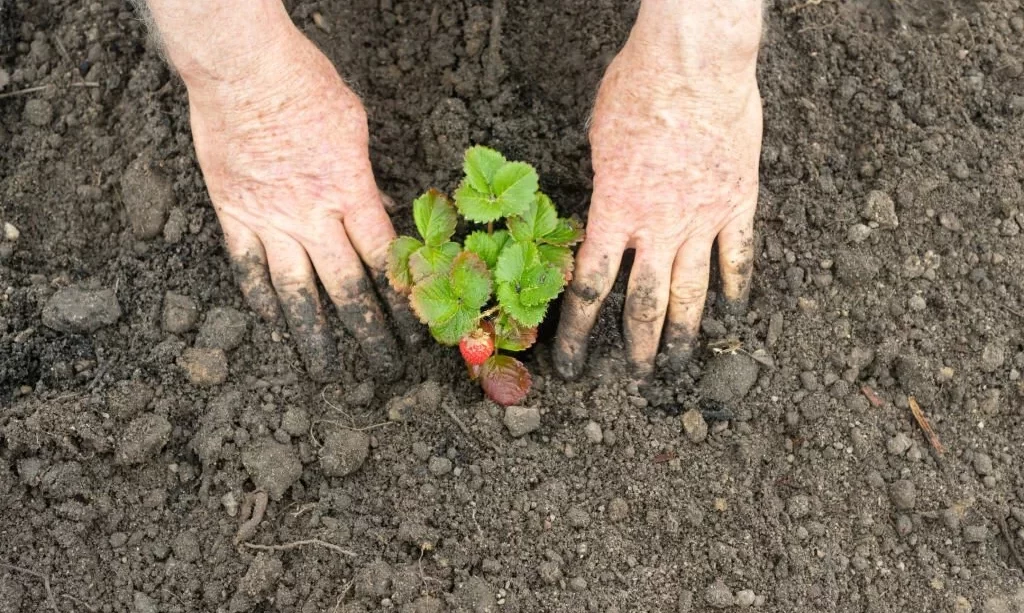Strawberries are a cherished delight in Ohio, where their sweet and juicy flavor is celebrated across the state. For Ohio’s gardeners, understanding the precise timing for planting strawberries is not just a matter of tradition; it’s a promise of enjoying homegrown, sun-kissed berries. In this guide, we will delve into the art of when to plant strawberries in Ohio, unravel the secrets of strawberry cultivation, and seize the unique opportunities that the state’s diverse regions offer for growing these delectable fruits.
- Planting and Growing Requirements: Before putting them outside they need to be started in a controlled environment as a plug or in a pot first. Like the red cup picture above.
- 1. Sunlight: Strawberry plants thrive in full sun, receiving at least 6 to 8 hours of direct sunlight daily. LED lighting is best. Window sill lighting usually only gets 2 to 3 hours direct sunlight.
- 2. Soil: Well-draining, loamy soil enriched with organic matter ( 70% soil and 30% play sand is idea) is ideal for bare root strawberry plants. Ensure the pH level of the soil is between 5.5 and 6.5 for optimal growth. Also, hydrate your soil first.
- 3. Planting Time: Plant bare root strawberries in early spring or late fall, ensuring the roots are well-spaced and spread out in the planting hole. Hydroponically anytime or indoor growing. Summer planting needs to be started indoors. If it is above 86 degree, cannot be started out in the field.
- 4. Spacing: Space strawberry plants approximately 8 to 10 inches apart in rows, leaving 2 feet between rows to allow for adequate airflow.
Strawberry Cultivation
Ohio’s gardeners are no strangers to the variety of strawberry types, including the ever-popular June-bearing, everbearing, and day-neutral varieties. Understanding the essentials of strawberry cultivation is the foundation of a successful harvest. Strawberries thrive in well-draining soil, abundant sunlight, and a climate with distinct seasons. Ohio’s varied regions cater to different types of strawberries, allowing enthusiasts to relish the fruits of their labor throughout the growing season.
Timing for Strawberry Planting
The timing of when to plant strawberries in Ohio is a critical piece of the puzzle, given the state’s diverse regions and climates. The ideal window for strawberry planting generally falls between late April and early June, but it’s essential to consider the following:
- Frost Dates: Ohio’s changing spring temperatures call for a careful look at frost dates. In southern Ohio, planting can commence in late April, while gardeners in the northern parts of the state may need to wait until early June to avoid late frosts.
- Strawberry Types: The choice of strawberry type is significant. June-bearing strawberries promise a bountiful harvest in late spring, while everbearing and day-neutral varieties offer multiple smaller harvests throughout the growing season. Select the type that best suits your local climate and preferred harvest times.
- Soil Preparation: Prior to planting, prepare your soil diligently. Ensure it is well-draining and enriched with organic matter, like compost or well-rotted manure, to provide essential nutrients and promote healthy root development.
Understanding the timing for strawberry planting in Ohio is like orchestrating a symphony, with each note contributing to the grand performance of a fruitful strawberry harvest. By considering these factors, Ohio gardeners can guarantee that their strawberry patch thrives and delivers the sweet taste of a fruitful summer.
Pre-Planting Preparations
Before you set your strawberry patch in Ohio into motion, a series of pre-planting preparations is essential:
- Soil Assessment: Start by conducting a soil test to understand the pH level and nutrient content of your soil. Strawberries thrive in soil with a pH between 5.5 and 6.5. If necessary, amend the soil to reach the desired pH using lime or sulfur, as indicated by the soil test results.
- Site Selection: Carefully choose the location for your strawberry patch. Opt for a sunny spot that receives at least 6-8 hours of direct sunlight daily. Adequate sunlight is vital for robust fruit production.
- Raised Beds or Mounded Rows: Consider creating raised beds or mounded rows for planting your strawberries. This setup ensures proper drainage, preventing waterlogging that can harm strawberry plants. Raised beds also simplify maintenance and minimize the risk of disease.
- Spacing and Layout: Plan the spacing and layout of your strawberry plants. Typically, strawberries are planted in rows with 12-18 inches between plants and 3-4 feet between rows. Proper spacing fosters good air circulation and minimizes the risk of disease.
- Incorporating Organic Matter: Enhance your soil’s fertility by incorporating organic matter like compost or well-rotted manure. Mixing organic matter into the soil before planting provides essential nutrients and improves soil structure, aiding in root development.
Planting Techniques
Practicing the right planting techniques is crucial for your Ohio strawberry patch’s success:
- Planting Depth: When planting strawberries, ensure that the roots are well-spread and the crowns (where the roots meet the stem) are at soil level. Planting too shallow can lead to root exposure and drying, while planting too deep hinders growth.
- Spacing: Adhere to the recommended spacing guidelines for your chosen strawberry type. Maintain the specified distance between plants and rows to allow the strawberry plants to grow without overcrowding.
- Watering: After planting, water your strawberries thoroughly to settle the soil and hydrate the roots. Continue to provide regular and consistent watering as the plants establish themselves. Strawberries require consistent moisture, especially during the flowering and fruiting stages.
- Mulching: Apply a layer of organic mulch around your strawberry plants to conserve soil moisture, regulate soil temperature, and suppress weed growth. Mulch also prevents soil from splashing onto the fruit, reducing the risk of diseases.
By adhering to these pre-planting preparations and planting techniques, your Ohio strawberry patch will be off to a promising start. Proper soil preparation, site selection, and layout set the stage for healthy strawberry plants that will bear sweet, juicy fruits to enjoy throughout the season.
Maintenance and Care
The care and maintenance of your Ohio strawberry patch are vital for a fruitful harvest:
- Watering: Consistent and thorough watering is essential for strawberry plants, especially during dry spells. The goal is to keep the soil consistently moist without overwatering. Adequate moisture is crucial for setting and ripening the fruit.
- Mulching: Maintain the mulch layer around your strawberry plants to conserve soil moisture, regulate soil temperature, and prevent weed growth. Mulch also serves as a barrier to protect fruit from coming into contact with the soil.
- Fertilization: Keep an eye on your strawberry plants for signs of nutrient deficiencies. Apply a balanced, slow-release fertilizer to June-bearing varieties after the first harvest and periodically for everbearing and day-neutral types to ensure they have the necessary nutrients for growth.
- Pest and Disease Management: Regularly inspect your strawberry plants for common pests such as slugs, aphids, and strawberry root weevils. Employ organic pest control methods or companion planting to deter these pests. Be vigilant for diseases like gray mold and leaf spot, taking prompt action if needed.
- Bird Protection: In Ohio, birds can be a significant challenge for strawberry growers. Consider using bird netting or other protective measures to prevent birds from enjoying your ripe berries before you do.
Harvesting and Storage
The moment of harvesting your homegrown strawberries is a culmination of your gardening efforts:
- Determining Readiness: It’s time to harvest your strawberries when they have reached their full, vibrant color and feel firm to the touch. June-bearing varieties yield the bulk of their harvest in late spring, while everbearing and day-neutral types offer multiple, smaller harvests throughout the season.
- Picking Strawberries: Gently pick the ripe strawberries from the plants, taking care not to damage the fruit or the plants themselves. The sweet scent of freshly picked strawberries is a joy to experience.
- Immediate Consumption or Preservation: Freshly picked strawberries are a delightful treat on their own or as ingredients in various culinary creations. If you have a surplus, consider preserving them by freezing, making jams, or drying them to savor their goodness year-round.
- Storage: Store freshly picked strawberries in the refrigerator, but they are at their peak flavor when enjoyed fresh. Strawberries are best enjoyed soon after picking.
Conclusion
Cultivating strawberries in Ohio is more than a pastime; it’s a connection to the state’s rich agricultural heritage and an opportunity to savor the sweetness of summer. By carefully timing your planting, choosing the right varieties, and providing attentive care throughout the growing season, you can savor the rewards of homegrown strawberries. These vibrant red gems are not only a treat for the taste buds but also a testament to the deep connection between your garden and Ohio’s agricultural traditions. So, prepare to relish the sweetness of your labor and celebrate the joy of Ohio’s very own homegrown strawberries.





